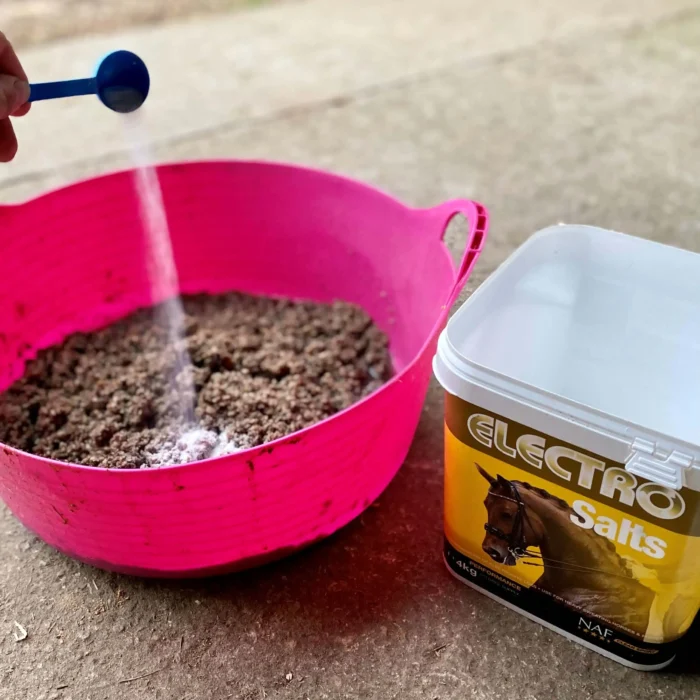With better weather finally here, our Horse Insurance team have been keen to find out more about how to effectively care for our equine friends when the temperature goes up. Who better to offer advice than the expert horse-care team over at leading feed and supplements company, NAF.
Kate Hore RNutr (Animal) and Head Nutritionist at NAF says: “As the temperature rises we’re hoping to get out and enjoy the weather with our horses, but if things hot up it’s important we know how to effectively cool them after they’ve worked up a sweat.

Why do horses get hot, and what is happening?
“All living creatures create heat as a normal part of cell function, and they are adapted to deal with that at maintenance. The harder the cells, i.e. the body, is working the more heat is produced. The body needs to maintain a balance between heat production and heat dissipation, but even on a cool day a hard-working horse may create more heat than he can easily lose quickly. If we add in the radiating warmth of the sun the issue can easily become a problem. If not controlled heat stress may impact, where the horse’s body is actively working to control that temperature rise to the detriment of another process – i.e. performance or recovery may suffer.
How do they cool?
Like all animals, horses can use four different pathways to deal with excess heat:
- Radiation - heat travels through air, for example the warmth of the sun
- Convection - heat transfers via moving gas or fluid, for example, a cooling breeze
- Conduction - heat transfers between objects via direct touch, for example, your hand warms when placed on a hot horse
- Evaporation - loss of heat through vaporisation of water or sweat, for example sweat losses
As natural athletes, horses are prolific sweaters, and losses of up to fifteen litres an hour are not un-heard of, dependent on temperature, humidity and exercise intensity1. Typically levels of around 5-7L in mild conditions or 10-12L in hot conditions are more usual – still very significant2.
How can we help?
When our horses or ponies are hot and sweaty it is important to cool them quickly and efficiently. We sometimes hear the outdated belief that suddenly cooling a horse is dangerous, but that isn’t true. There is no evidence to suggest that you can cool any athlete too quickly, but you can cool them too far, so ensure you only take them back to their normal temperature. The most effective way to cool a horse is by continued application of water, either hosing or simply sponging down from a bucket if necessary. There’s no need to stop and scrape as you go, as this offers no further benefit. Simply keep applying that water until the horse has cooled.
Myth busting
- You cannot cool a hot horse too quickly.
- No need to stop and scrape, water on the horse does not heat them up.
For most horses in mild conditions, or not working to elite levels, simply cooling with plenty of water immediately after exercise will cool effectively. Add a couple of capfuls of NAF Cooling Wash. This no-rinse formula is designed to cool, relax and refresh tired horses.
For heavily sweating horses, latest research suggests that major muscle groups remain at a higher temperature for longer, compared to respiration and heart rates which both drop rapidly on hosing. Further research is needed to fully understand the timelines, but for hot horses it is advised to hose immediately, cool further by walking, allow recovery in the stable with an electrolyte feed and water, and then hose again a few hours later to help those large muscles masses return to normal temperatures.
Replacing sweat losses
Remember for any sweating horse they don’t just lose water in sweat but electrolytes too. These are essential body ions, vital to many pathways in the body including hydration, muscle function. The most important electrolytes lost are sodium, potassium and chloride together with smaller amounts of magnesium and calcium, so ensure that you replace with a broad-spectrum electrolyte product, such as NAF ElectroSalts, that covers all bases. Add to a sloppy wet feed, or train your horse to take his electrolytes in water – as it is essential the water is replaced alongside the electrolytes. Whilst sweat losses are significant they don’t have to be replaced all in one go. Following competition, travel or hard work, add ElectroSalts to their daily feed for a few days to fully replenish.

To find out more about further research Kate has carried out on electrolyte losses in horses and how to accurately ‘Sweat Score’ your horse click here.
Keep cool and carry on
Kate suggests:
- Exercise your horse appropriate to their fitness levels, and start a fitness programme early in the season.
- Cool by applying water continually.
- Offer forage not concentrates after sweating and before their ElectroSalts, to encourage water intake.
- Ensure clean, fresh water is always available.
Many thanks to Kate Hore RNutr (Animal) and Head Nutritionist at NAF for sharing this expert knowledge on promoting the welfare of our horses and ponies in the Summer heat.
About SEIB
SEIB Insurance Brokers are specialists in insurance for Horses, Horsebox Insurance and Horse Trailer Insurance. We are able to provide flexible policies to suit individual client needs and provide advice on what cover is needed
References: 1. Davis M. Heat Stress: A comparative approach between species and disciplines. 27th KER Equine Health and Nutrition Conference. (2024). Ocala, Florida. 2. Pagan J. New methods for studying heat stress in horses. 27th KER Equine Health and Nutrition Conference (2024). Ocala, Florida.